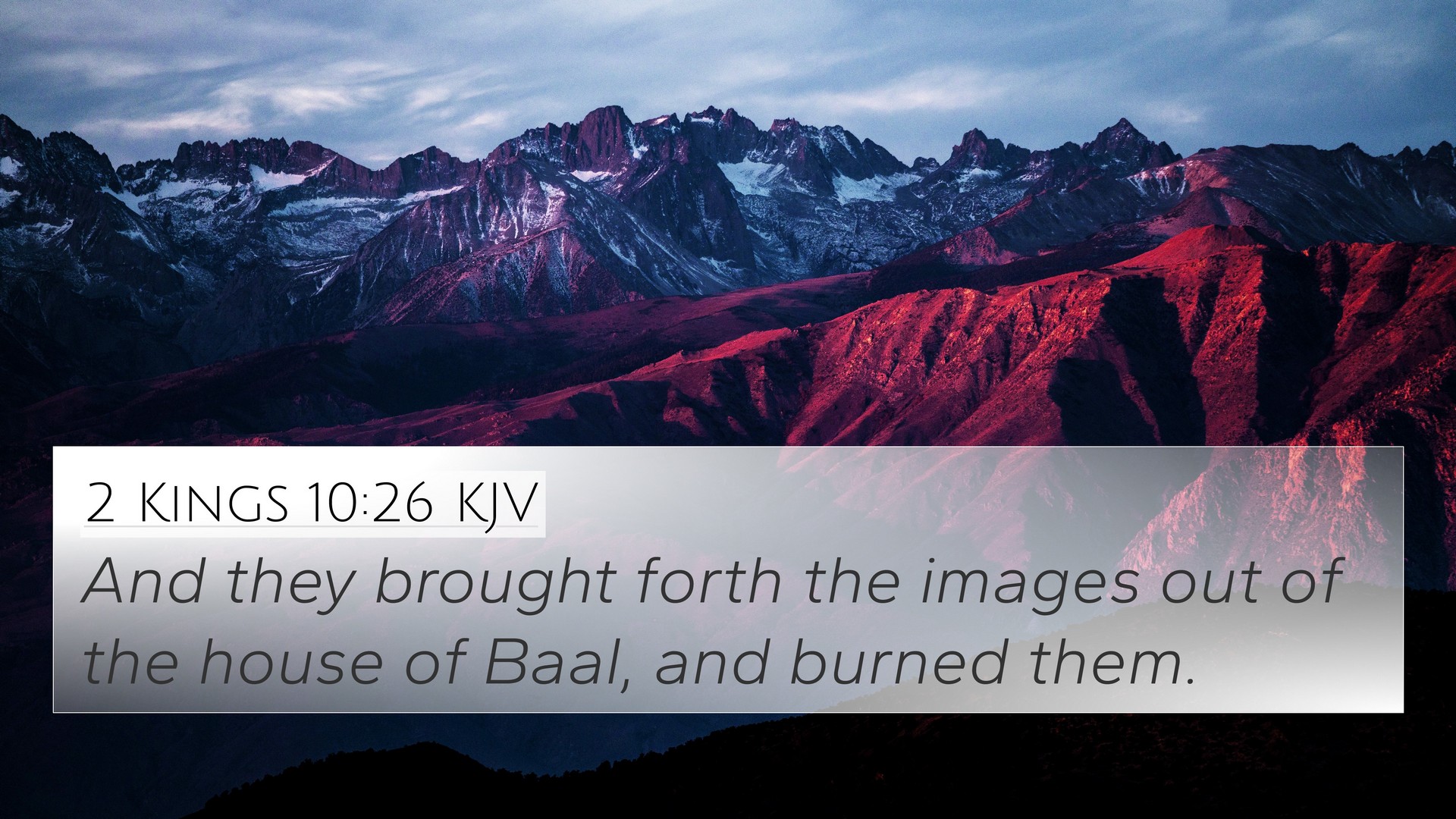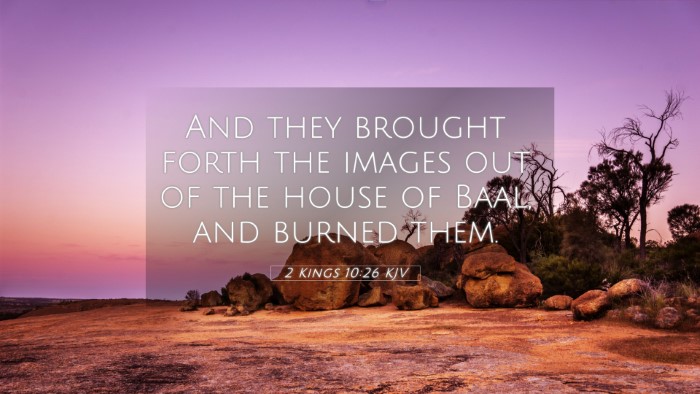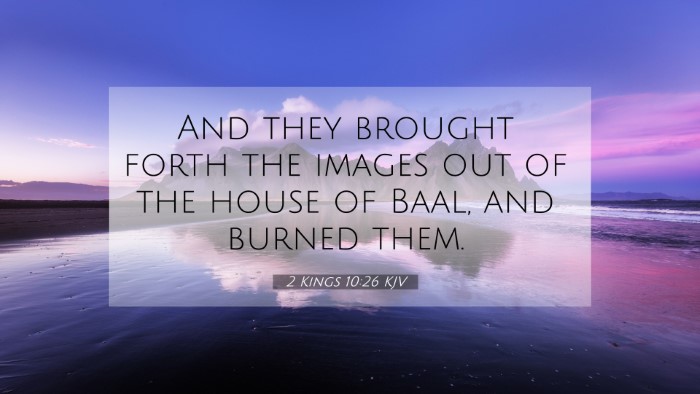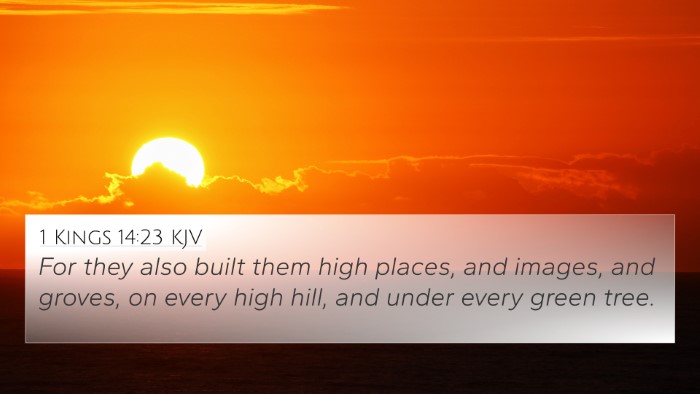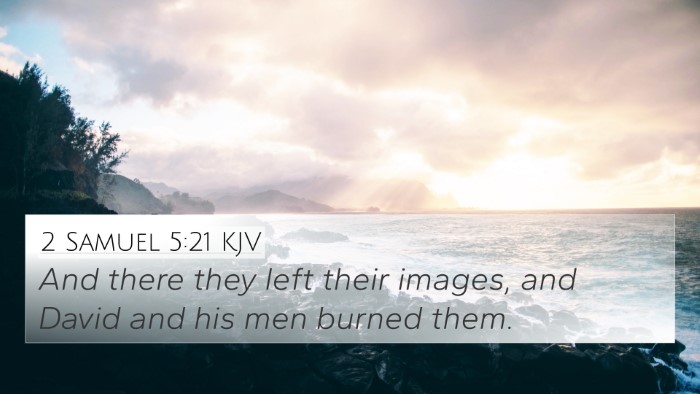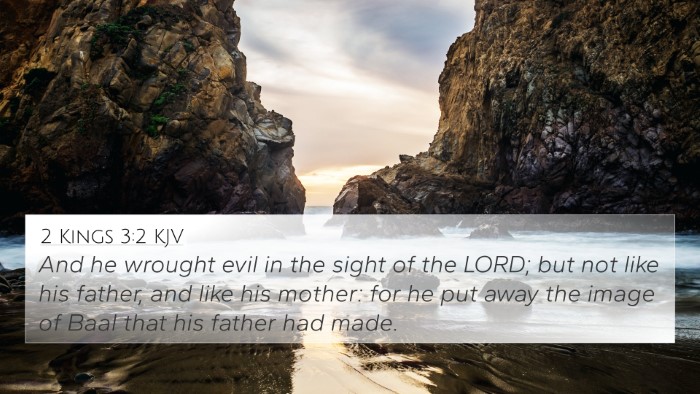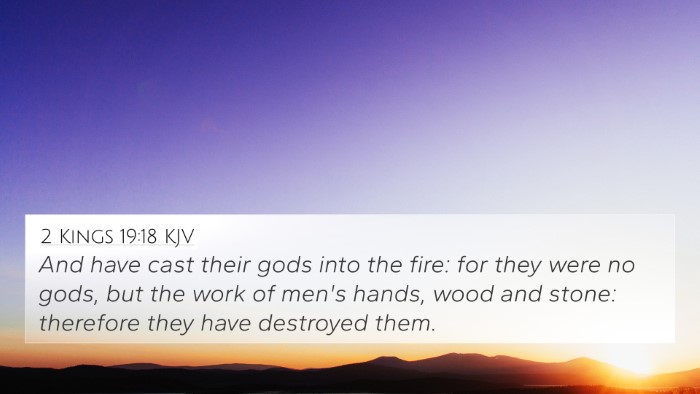Understanding 2 Kings 10:26
2 Kings 10:26 states: "And they brought forth the images out of the house of Baal, and burned them." This verse is pivotal in understanding the actions of King Jehu during his reign in Israel.
Summary of the Verse
This verse captures a decisive moment in the narrative of King Jehu’s efforts to eradicate the worship of Baal from Israel. Jehu’s zeal was directed towards purging the land of idols, particularly those associated with Baal worship, which had led the nation astray. The act of burning the images signifies a full rejection of these idols, marking a significant step towards restoring proper worship of Yahweh.
Commentary Insights
Drawing from recognized public domain commentaries:
Matthew Henry’s Commentary
Matthew Henry highlights that this action demonstrates Jehu's commitment to eliminate Baal worship both as an act of loyalty to God and as a fulfillment of the prophecy against Ahab’s house. Henry underscores the importance of destruction versus mere removal, indicating that Jehu sought to annihilate the very symbols of idolatry, ensuring that they would not return to influence the people again.
Albert Barnes' Notes on the Bible
Albert Barnes elaborates on the significance of this event by connecting it to Deuteronomy 12:3, which commands the destruction of the images of the false gods. He emphasizes that Jehu was not merely performing a political act but was engaging in a religious reform that was essential for the spiritual health of Israel. Barnes suggests that Jehu’s actions reflect a broader theme within the Scriptures regarding the necessity of purging sin and falsehood to restore true worship.
Adam Clarke’s Commentary
Adam Clarke provides an analysis focusing on the cultural and religious implications of the act. He notes that Baal worship had deeply penetrated Israelite society. Clarke interprets the burning of the images as a public declaration against the prevailing idolatry, symbolizing a clean break from past allegiances to Baal. He also reflects on the broader consequences of such a purification, suggesting that it sets the stage for future generations to understand the importance of exclusive worship to Yahweh.
Links to Other Bible Verses
This verse is interwoven with numerous themes and teachings found throughout the Bible. Here are some key cross-references:
- Deuteronomy 12:3: "And ye shall overthrow their altars, and break their pillars, and burn their groves with fire; and ye shall hew down the graven images of their gods, and destroy the names of them out of that place."
- 1 Kings 18:21: "And Elijah came unto all the people, and said, How long halt ye between two opinions? if the Lord be God, follow him: but if Baal, then follow him."
- 2 Kings 10:27: "And they brake down the image of Baal, and brake down the house of Baal, and made it a draught house unto this day."
- Jeremiah 44:23: "Because ye have burned incense, and because ye have sinned against the Lord, and have not obeyed the voice of the Lord, nor walked in his law, nor in his statutes, nor in his testimonies."
- Isaiah 44:15-19: Discusses the futility of idol worship and the foolishness of making idols from wood.
- Hosea 14:8: "Ephraim shall say, What have I to do any more with idols?"
- Matthew 6:24: "No man can serve two masters..." suggesting that loyalty cannot be divided.
- Revelation 21:8: "But the fearful, and unbelieving, and the abominable, and murderers, and whoremongers, and sorcerers, and idolaters..." highlighting the fate of idolaters.
Thematic Connections
The act of burning idols in 2 Kings 10:26 aligns thematically with the broader narrative of God’s expectation for His people to remain faithful. Here are some thematic connections:
- Idolatry vs True Worship: The call for Israel to turn from idols is echoed throughout the scriptures and serves as a recurring theme.
- Judgment and Reform: The actions of leaders like Jehu reflect the biblical principle that leaders have a profound obligation to lead their people in righteousness.
- Consequences of Sin: The destruction of the Baal images serves as a reminder of God’s judgment against sin, emphasizing that ignoring such commands leads to dire consequences.
Conclusion
2 Kings 10:26 serves as a critical example of the lengths to which leaders must go to restore true worship among God's people. By examining the connections between this verse and others, we can gain a broader understanding of its implications and the necessity of rejecting all forms of idolatry in pursuit of a faithful relationship with God.
SEO Keywords Integration
Understanding how 2 Kings 10:26 relates to other scriptures provides valuable insights for Bible studies. This verse exemplifies the connections between Bible verses, while also being a perfect example of Bible verse parallels. In studying this verse, those interested in cross-referencing Biblical texts will find a wealth of material on themes of idolatry and reform. By using tools for Bible cross-referencing, scholars can delve deeper into the thematic Bible verse connections present within the larger biblical narrative.
